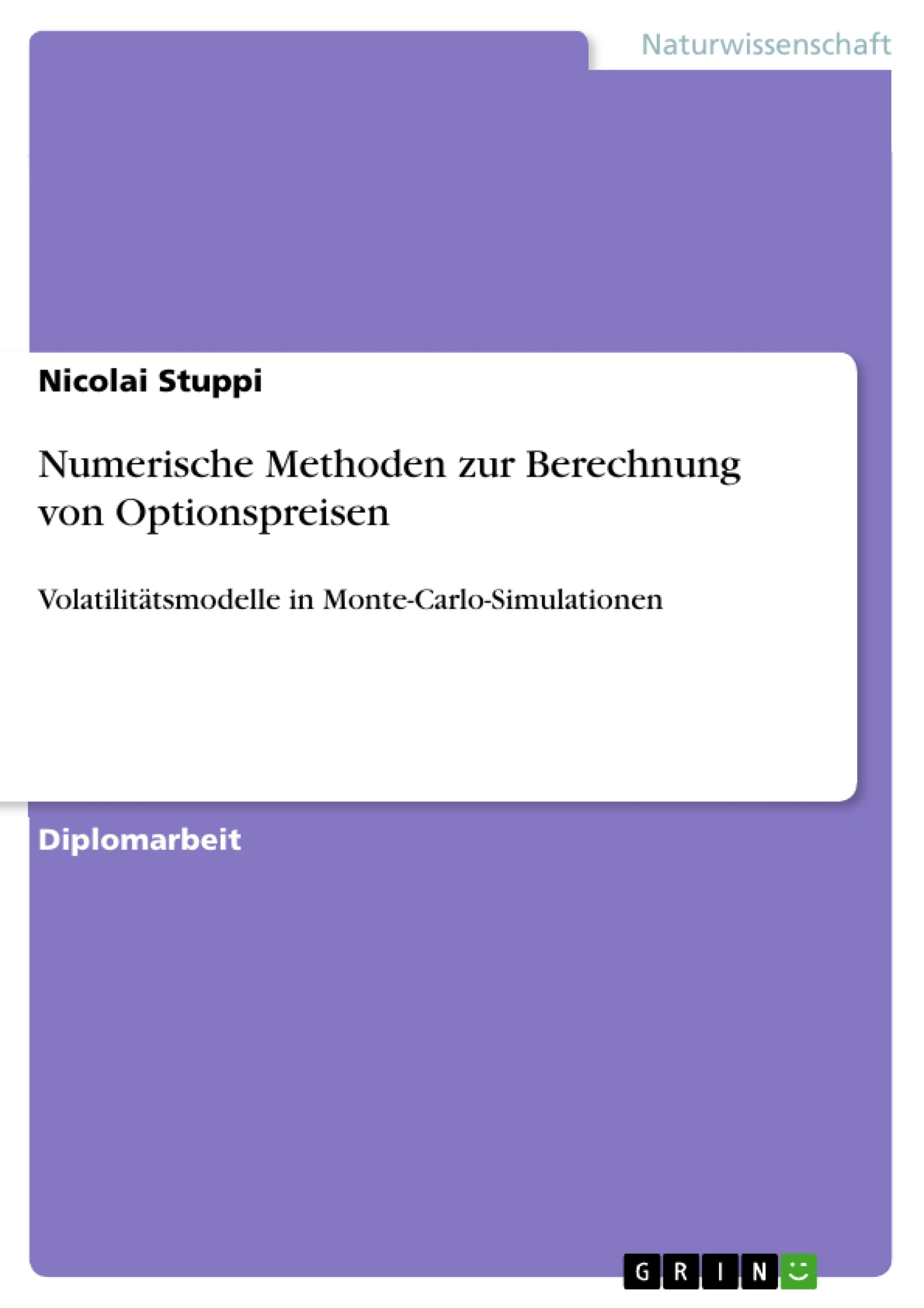In unserer Arbeit stellen wir numerische Methoden zur Berechnung von Optionspreisen vor. Wir erachten dies gerade in Anbetracht der aktuellen Finanzkrise (Subprimekrise seit 2007), die unter anderem aufgrund des short-sellings von Optionsscheinen hervorgerufen wurde, als ein äußerst wichtiges Teilgebiet der angewandten Mathematik. Um dem Leser den Einstieg in die
Problematik der mathematischen Modellierung des Finanzmarkts zu erleichtern, werden wir in Kapitel 2 auf die grundlegenden Definitionen und Sachverhalte, die im Bezug zu dieser Arbeit stehen, eingehen.
Im Folgenden verwenden wir tatsächliche Aktien- und Optionswerte der letzten 10 Jahre und analysieren diese in verschiedenen Volatilitätsmodellen und zeigen unsere Prognosen für die nächsten Jahre an Hand der dazugehörigen Trinomialbäume und der Monte-Carlo-Simulation.Unter anderem verwenden wir das Heston-Modell als ein stochastisches Volatilitätsmodell.
Inhaltsverzeichnis
- 1 Einleitung
- 2 Grundlegende Definitionen und Sachverhalte
- 2.1 Begriffe aus der Optionstheorie
- 2.2 Wahrscheinlichkeitstheoretische Grundlagen
- 2.3 Das Finanzmarktmodell
- 2.4 Die Dynamik des Aktienkurses
- 3 Das Black-Scholes Modell zur Optionspreisberechnung
- 3.1 Herleitung der Black-Scholes Gleichung
- 3.2 Die Kennzahlen des Black-Scholes Modells
- 3.2.1 Delta
- 3.2.2 Gamma
- 3.2.3 Theta
- 3.2.4 Rho
- 3.2.5 Vega oder Kappa
- 4 Die Volatilität
- 4.1 Historische Volatilität
- 4.2 New Volatility
- 4.3 Implizite Volatilität
- 4.4 Stochastische Volatilität
- 4.5 Lokale Volatilität
- 5 Historische Volatilität und New Volatility als Kriterien der Portfolioauswahl mit Hilfe des Black-Scholes Modells
- 5.1 Portfolio 1 (große Werte der historischen Volatilität)
- 5.2 Portfolio 2 (kleine Werte der historischen Volatilität)
- 5.3 Portfolio 3 (große New-Volatility Werte)
- 5.4 Portfolio 4 (kleine New-Volatility Werte)
- 6 Auswertung der Portfolios mit statistischem Test durch Betrachtung der tatsächlichen Weiterentwicklung der Aktien nach 4 Monaten
- 7 Optionspreisberechnung durch Baummodelle
- 7.1 Die Geschichte der Baummodelle
- 7.2 Binomialbäume als Berechnungsgrundlage für Optionsscheine
- 7.3 Trinomialbäume
- 7.4 Implizite Theorie
- 7.5 Implizite Binomialbäume
- 7.6 Konstruktion eines impliziten Trinomialbaumes
- 8 Optionspreisberechnung durch Monte-Carlo-Simulation und der Effekt der verschiedenen Volatilitätsmodelle
- 8.1 Grundidee
- 8.2 Zufallszahlen
- 8.2.1 Algorithmen zur Erzeugung gleichverteilter Zufallszahlen
- 8.2.2 Erzeugung normalverteilter Zufallszahlen
- 8.3 Monte-Carlo Simulation einer europäischen Call-Option
- 8.4 Konvergenz bezüglich der numerischen Integration stochastischer Differentialgleichungen
- 8.5 Das Heston-Modell in Monte-Carlo-Simulationen (stochastisches Volatilitätsmodell)
- 8.5.1 Asiatische Option im Heston-Modell
- 8.5.2 Kalibrierung des Heston-Modells mit aktuellen Marktdaten für europäische Option
- 8.6 Lokales Volatilitätsmodell
- 8.7 Vergleich der Volatilitätsmodelle
Zielsetzung und Themenschwerpunkte
Diese Diplomarbeit befasst sich mit der numerischen Berechnung von Optionspreisen. Ziel ist es, verschiedene Methoden zur Optionspreisberechnung zu untersuchen und zu vergleichen.
- Vergleich verschiedener Volatilitätsmodelle (historische, implizite, stochastische, lokale Volatilität)
- Anwendung des Black-Scholes Modells und dessen Kennzahlen
- Anwendung von Baummodellen (Binomial- und Trinomialbäume)
- Anwendung von Monte-Carlo-Simulationen
- Portfolioauswahl basierend auf Volatilitätskennzahlen
Zusammenfassung der Kapitel
Kapitel 1 dient als Einleitung. Kapitel 2 beschreibt grundlegende Definitionen und Konzepte aus der Optionstheorie, Wahrscheinlichkeitstheorie und dem Finanzmarktmodell. Kapitel 3 erläutert das Black-Scholes Modell zur Optionspreisberechnung und seine Kennzahlen. Kapitel 4 befasst sich mit verschiedenen Volatilitätsmodellen. Kapitel 5 untersucht die Anwendung der historischen und New Volatility im Kontext der Portfolioauswahl mit dem Black-Scholes Modell. Kapitel 6 beschreibt die statistische Auswertung der Portfolios. Kapitel 7 behandelt die Optionspreisberechnung mittels Baummodellen. Kapitel 8 widmet sich der Optionspreisberechnung durch Monte-Carlo-Simulation und dem Einfluss unterschiedlicher Volatilitätsmodelle.
Schlüsselwörter
Optionspreisberechnung, Black-Scholes Modell, Volatilität (historisch, implizit, stochastisch, lokal), Baummodelle, Monte-Carlo-Simulation, Portfolioauswahl, Risikomanagement.
- Quote paper
- Nicolai Stuppi (Author), 2011, Numerische Methoden zur Berechnung von Optionspreisen, Munich, GRIN Verlag, https://www.hausarbeiten.de/document/183128


